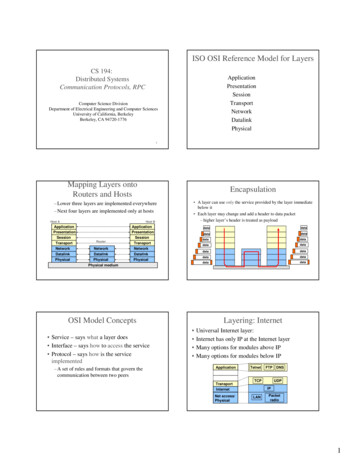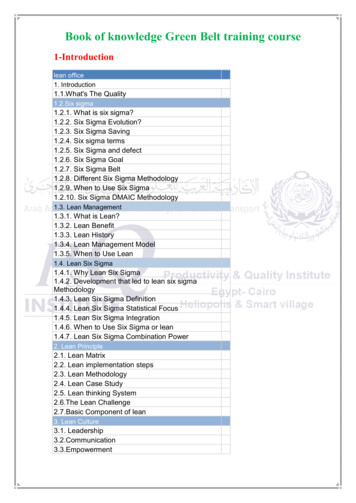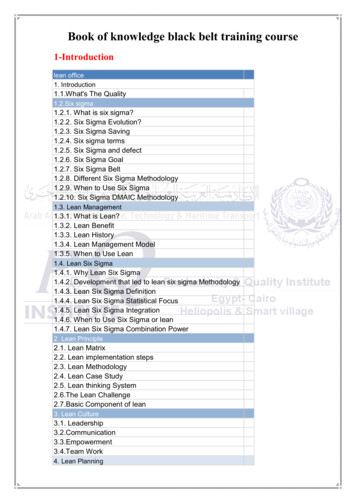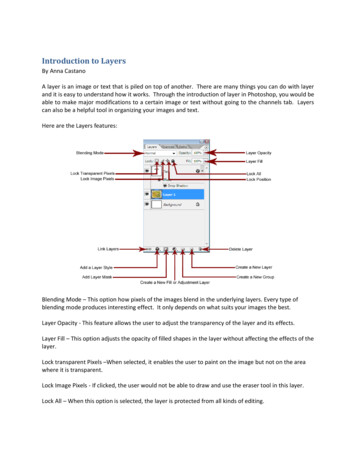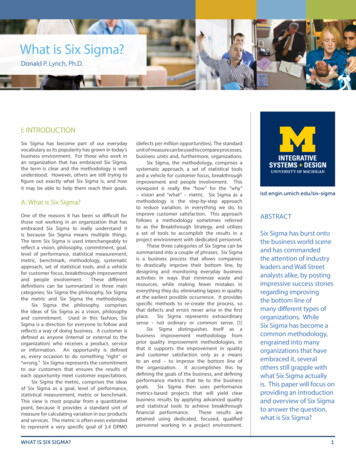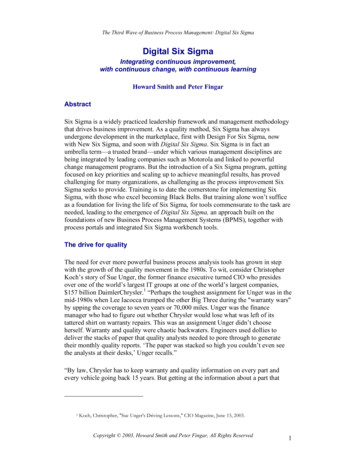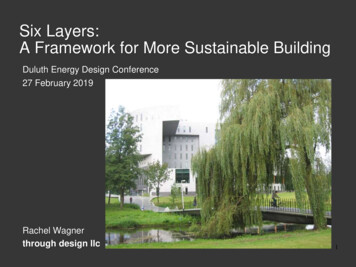
Transcription
Six Layers:A Framework for More Sustainable BuildingDuluth Energy Design Conference27 February 2019Rachel Wagnerthrough design llc1
In accordance with the Department of Labor andIndustry’s statute 326.0981, Subd. 11,“This educational offering is recognized by theMinnesota Department of Labor and Industry assatisfying 1.5 hours of credit toward BuildingOfficials and Residential Contractorscontinuing education requirements.”For additional continuing education approvals,please see your credit tracking card.2
Learning Objectives1.Apply a practical, holistic future-oriented definition ofsustainability to building.2.Review the basic concepts of integrated design.3.Learn about the Theory of the Shearing Layers presented inthe book book “How Buildings Learn/What happens afterthey’re built.”4.Using lessons from the book “How Buildings Learn,” see howlongevity and adaptability of a building affects its usefulnessand sustainability.5.Think about how the hierarchy in the layers can impact thelongevity and usefulness of a building, both good and bad.6.Understand the significance of the 6 Layers framework as aguide to help inform decisions in design and construction.3
What’s At Stake?“Well, the first thing is that buildings consume alot of resources. And I think most of us know that,but they don’t realize the extent to which buildingsuse resources. It’s the most consumptive kind ofindustry on the planet. And they also pollute, displace, and destroyhabitats.”-Professor John Straube, University of Waterloo, 20094
Sustainability“What we need to learn is to make not just anything, but (to make) the right thing, and make it tolast for as long as possible.”John Ehrenfeld, “Flourishing – A Frank Conversation about Sustainability”5
“The Right Thing” according to theWhole Building Design Guide (c.2018)“The main objectives of sustainable design areto reduce, or completely avoid, depletion ofcritical resources like energy, water, land, andraw materials; prevent environmentaldegradation caused by facilities andinfrastructure throughout their life cycle; andcreate built environments that arelivable, comfortable, safe, and es/sustainable6
The Right Thing, SimplifiedImage from circularecology.com7
Integrated Design"When we try to pick out anything by itself, wefind it hitched to everything else in theUniverse."- John Muir (1838-1914), engineer, naturalist8
Think critically and early9
Critical ThinkingAnalysisRigorImaginationCommonSense10
11
Theory of Shearing LayersImage from communionarchitect.com12
Shearing Layers of Change“A building properly conceived is severallayers of longevity of built components.”Frank Duffy, as told to Stewart Brand, “How BuildingsLearn”“Because of the different rates of change ofits components, a building is always tearingitself apart.”Steward Brand, “How Buildings Learn”13
“Thinking about buildings in this time-ladenway is very practical. As a designer you avoidsuch classic mistakes as solving a fiveminute problem with a fifty-year solution, orvice versa.”Frank Duffy, “How Buildings Learn”14
SignificanceThe approach to every layer hasimplications for long-term economic,social and environmental impact In essence, Sustainability.15
Site Essentially eternal Geographic location Land features, boundaries Surrounding context16
“Site is eternal.”Frank Duffy, “How Buildings Learn” by Steward Brand17
There is a hierarchy to the layersWhat is done initially to the first twolayers, Site and Structure, is theleast easily changed after the initialconstruction and may have thelongest impact (positive or negative).18
What we choose to develop matters.Image from kissmytractor.blogspot19
Location, Location, LocationImage from www.financial-planning.com20
Structure 60 - 100 years or moreFoundationLoad bearing structureLongest lasting of the built elementsInsulation and services may be embedded here21
Placing a building has lasting impactGood water management begins with the SITE.22
Keep the Structure Strong and DurableDone Right the First TimeImage from concreteconstruction.netFixing Things23
It’s only easy to insulate under thefoundation once24
Skin 20 – 100 years Water management/protective layer Exterior surfaces: roof, siding, sheathing, windows Not all elements wear out at the same rate Insulation and services may be embedded here25
The “Skin” often has the biggest impacton long-term durability, occupant comfortand building energy performance.Image by Mark Teskey26
More Than Skin Deep27
Integrated Design in Practice“How a room is heated depends on how itrelates to the heating and cooling Services,which depend on the energy efficiency ofthe Skin, which depends on the constraintsof the Structure.”Steward Brand, “How Buildings Learn”28
Services 7-30 yearsPlumbing, heating, cooling, ventilation, electricalDistribution systems harder to change than plantsReplaced from wear or obsolescenceKitchens and Baths are most remodeled rooms29
Avoiding obsolescence“The longevity of buildings is oftendetermined by how well they canabsorb new Services technology.”Stewart Brand, How Buildings Learn30
Access to Services Aids Adaptability31
Does the Investment Match the Lifespan?32
Space 5 – 40 years Considered mutable, changeable withoutchanging structure, services, or skin The building interior: Partitions, surface finishes, fixtures, doors33
Often a big investment, and often changed.Image from www.batchelor-resort.com34
Stuff ImpermanentThings easily movableMost frequently changed by occupantAppliances, lamps, electronics, furniture, art35
What doesn’t last goes somewhere.“The opposite of adaptation in buildings is graceless turnover.”Steward Brand, “How Buildings Learn”36
The Significance of the Framework:Context and Perspective37
Sustainability Takes the Long View“An adaptive building has to allow slippagebetween the differently-paced systems of Site,Structure, Skin, Service, Space Plan, and Stuff. Embedding the systems together may lookefficient at first, but over time it is the opposite,and destructive as well.”Stewart Brand, “How Buildings Learn”38
Walls are Inherently Complicated39 They may be structural. They connect tofoundation, floor, androof. We cut holes in them. We attach things to theoutside of them. We attach things to theinside of them. They may contain MEPsystems.
Structure, Skin and Space Collide40
Separate Structure, Plan for Change Create cavities for services: Walls Soffits Dropped ceilings Chases Allow for windowreplacement withoutdismantling surroundingfinishes Don’t embed exteriorelements into interiorelements (decks, awnings) Expose some mechanicals41
Toward Creating an Adaptive BuildingWolf Haus wall with Service Cavity www.wolf-haus.deEcocor’s Passiv Wall www.ecocor.us/walls42
Using the Framework: Questions to Ask1.Which layer(s) will this choice impact?2.Are we investing enough in Site and Structure?3.Are we over-investing in Space and Stuff?4.Will the Services be easily accessible for repair,maintenance and replacement?5.Do the details support longevity of structure?6.How does the design allow for alteration?43
“Age plus adaptivity is what makes abuilding come to be loved.”Steward Brand, “How Buildings Learn” 44
Resources Bioregional Green Building Advisor https://www.greenbuildingadvisor.com/ Canada Green Building Council U.S. Green Building Council Building Green https://www.buildinggreen.com/ Myths about Green /common-mythsabout-green-building cor.us/Good Books How Buildings Learn/What happens after they’re built byStewart Brand The Timeless Way of Building by Christopher Alexander45
Thank you.throughdesign.netrachel@throughdesign.net46
longevity and adaptability of a building affects its usefulness and sustainability. 5. Think about how the hierarchy in the layers can impact the longevity and usefulness of a building, both good and bad. 6. Understand the significance of the 6 Layers framework as a gui
